Last week”s episode: Lyon Biennale – Pedro Reyes.
Biennale of contemporary art in Lyon chose The Spectacle of the Everyday as its seemingly unglamorous theme.
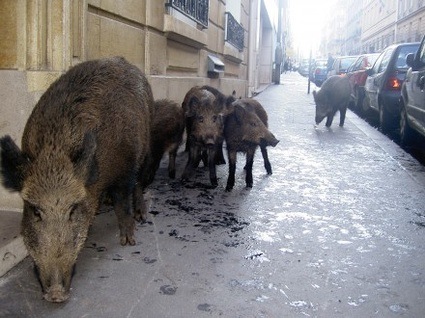 Adel Abdessemed, Sept frères, 2006
Adel Abdessemed, Sept frères, 2006
As Curator Hou Hanru explained: In today’s world existing means being part of the spectacle – that’s the situation we’re in. Everything’s spectacle: any image in a magazine, any exhibition, etc. And in that same world there’s also what’s called the “everyday”: a living, shifting terrain on which people come up with all kinds of ways of resisting the implacable logic of consumption as embodied in the spectacle.
The idea for the Bienniale is to use the spectacle to spotlight this invisible world of the everyday and the ceaseless creation that goes on within it.
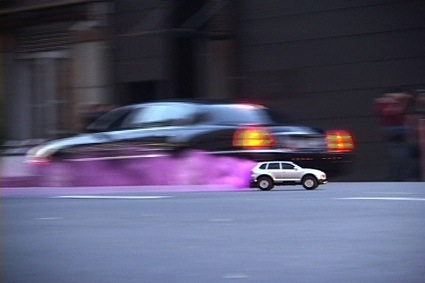 HeHe, Toy Emissions (My Friends all drive Porsches), 2007
HeHe, Toy Emissions (My Friends all drive Porsches), 2007
The Spectacle of the Everyday celebrated contemporary artists who believe that art has to offer more than a spectacle, that it can reinvent itself through engagements with the challenges brought about by everyday life. I was surprised to read that the biennale had been panned by critics in France. The Spectacle of the Everyday was trying to give too many lessons. In a simplistic way and without much regard for form, they wrote. I’m not haughty enough to believe that none of us deserves to be reminded of a few unpleasant facts once in a while. While some of these lessons might not always be very subtle and well-articulated, they have at least the merit of trying and opening up a space for reflection.
The event was distributed into several venues in and around Lyon. Which is great if your idea of a fun time in Lyon involves spending hours inside buses, trams and metros.
The main exhibition venues is La Sucrière, a former sugar factory on the River at the edge of the city. La Sucrière showed the most compelling artworks, it also presented the most coherent and intelligent exhibition. It was down-to-earth, accessible to all audiences and didn’t feel the need to play the provocative card. In that respect, the exhibition reached quite competently its purpose to bring contemporary creation closer to everyday life. I doubt i’ll blog about the other venues though.
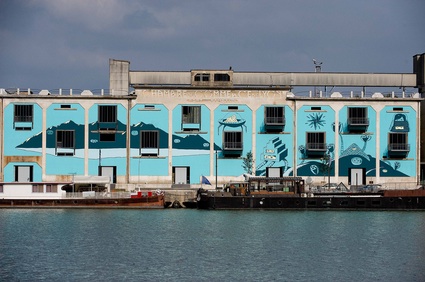 Eko Nugroho, cut the montain and let it fly, 2009. Photo : Blaise Adilon
Eko Nugroho, cut the montain and let it fly, 2009. Photo : Blaise Adilon
One of the external walls of the exhibition space became the canvas for Eko Nugroho‘s Cut the Mountain and Let It Fly , a 70 by 15 meter-long mural.
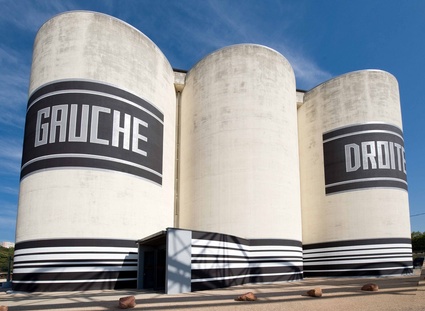 Rigo 23, Gauche Droite, 2009. Photo: Blaise Adilon
Rigo 23, Gauche Droite, 2009. Photo: Blaise Adilon
Meanwhile, the silos of the ex-sugar factory have been painted in black and white by Rigo 23. The letters say “Gauche” and “Droite” (“Left, right”). And that’s exactly the position of the silos if you raise your head while entering the exhibition space. “Unless,” say the exhibition guide, “you turn round, of course, in which case it’s the opposite. Turning round: the minimal experience that casts doubt on the strictly relative values of our certainties.” I’ll let you ponder on that.
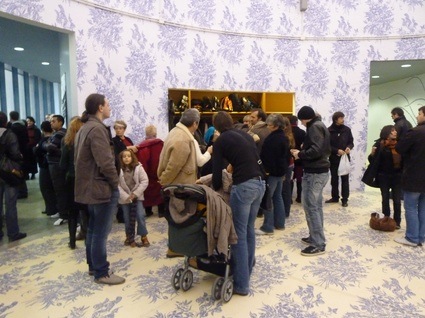 Tsang Kinwah, Let us Build and Launch a Blue Rocket to his Heaven, 2009
Tsang Kinwah, Let us Build and Launch a Blue Rocket to his Heaven, 2009
Tsang Kinwah’s wallpapers cover the entrance hall. From afar, they look like delicate flowers in the decorative-art style of William Morris. Until you stop and realize they are patterns made of words that are at odds with the floral ornament: “Vive la France”, “The Glory of Human Beings”, “Il faudrait les supprimer”, “Where is God,” and “Fucking Heaven”.
All of the above makes me wonder why nowadays the only paintings deemed worthy to enter a biennale of contemporary art are site-specific paintings, wallpapers or graffiti.
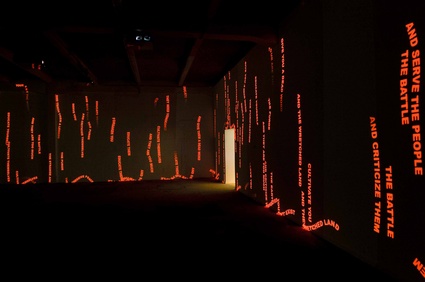 Kin-Wah TSANG, The Second Seal – Every Being That Opposes Progress Shall Be Food For You, 2009. Photo: Blaise Adilon
Kin-Wah TSANG, The Second Seal – Every Being That Opposes Progress Shall Be Food For You, 2009. Photo: Blaise Adilon
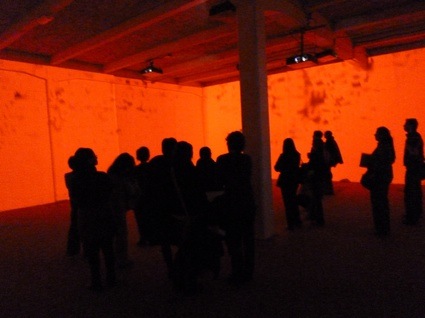
Kinwah spread its magic again on the upper floor at La Sucrière. This time with an animated video version of his coloured texts. Both menacing and seducing, the sentences descend like lava on the walls the space, they bounce on the floor and gradually ignite the whole room. They talk of battle, purge, wretched land and the necessity to educate oneself. They utter haiku-like aphorisms “One race, one colour”, “The horse, the sword and the festival”, “The sun, the earth and red”, “one people, one country”. The title of the artwork doesn’t dispense more cheerfulness. The Second Seal – Every Being That Opposes Progress Shall Be Food For You refers to the Apocalypse of John. The Second Seal bringing about war and a soldier with a sword riding a Red Horse.
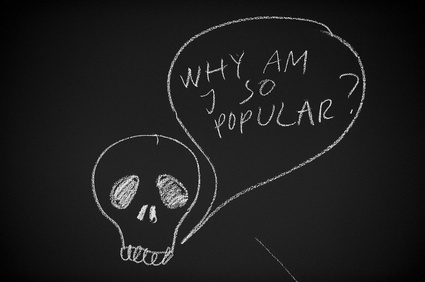 Dan Perjovschi, The Everyday Drawing 1, detail, 2009. Photo : Blaise Adilon
Dan Perjovschi, The Everyday Drawing 1, detail, 2009. Photo : Blaise Adilon
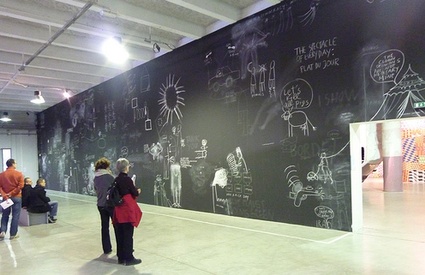
The now ubiquitous Dan Perjovschi graced 2 floors of the Sucrière with his white chalk on black wall drawings.
Everyday, the artist sent by email a drawing inspired by what made the headlines of the press. The Biennale staff then erased one of the drawings on the black board and dutifully copied the new one instead. Cynical, spot-on, the commentary responds to the latest news while addressing at the same time the -alas immutable- issues of our time: the distribution of wealth, globalisation, religion, migrations, the art market, global warming.
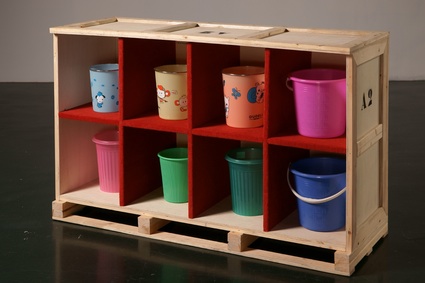 Michael Lin, What a Difference a Day Made, 2008. Photo : Blaise Adilon
Michael Lin, What a Difference a Day Made, 2008. Photo : Blaise Adilon
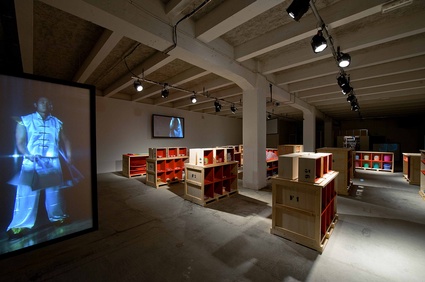 Michael Lin, What a Difference a Day Made, 2008. Photo : Blaise Adilon
Michael Lin, What a Difference a Day Made, 2008. Photo : Blaise Adilon
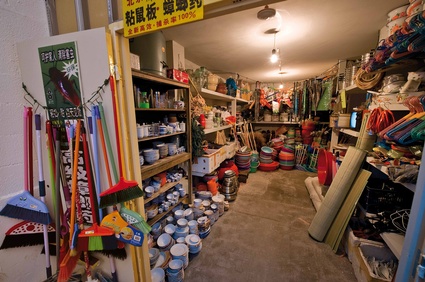 Michael Lin, What a Difference a Day Made, 2008. Photo : Blaise Adilon
Michael Lin, What a Difference a Day Made, 2008. Photo : Blaise Adilon
Michael Lin bought the entire stock of a hardware store in Shanghai, cataloged all its content, had it shipped to Lyon and rearranged it, adding music, video and performance. The objects of “What a Difference a Day Made” are presented according to colour, shape and use into elegant wooden displays, as in a natural history museum. The installation reminds us that the modest everyday existence of an obscure shop is also part of our collective memory – and something maybe capable of becoming a work of art in its own right.
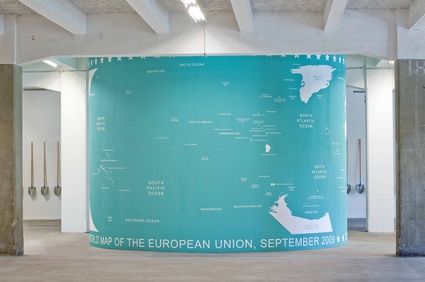 Société Réaliste, EU Green card lottery : the lagos file, 2006-2009. Photo : Blaise Adilon
Société Réaliste, EU Green card lottery : the lagos file, 2006-2009. Photo : Blaise Adilon
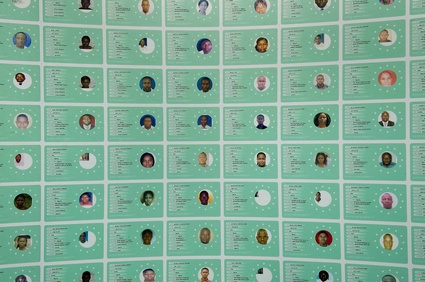 Société Réaliste, EU Green card lottery : the lagos file, 2006-2009. Photo : Blaise Adilon
Société Réaliste, EU Green card lottery : the lagos file, 2006-2009. Photo : Blaise Adilon
The Green Card can be won in a free lottery organised on the Internet by the American government. The project EU Green Card Lottery mirrors the program and suggests to Americans that they should reverse the immigration flow by demanding a green card to Europe. The moment Société Réaliste (“Realistic Society”) launched the website of the project, it was besieged by demands from Third World candidates unaware that it was a fake.
The installation at the Biennale invites visitors to take the point of view of the immigration officer who has to review myriads of identity data and portraits of candidates for the European Green Card.
As the artists explained in an interview for Provision Library, the project addresses immigration management in our ‘globalized,’ ‘cosmopolitan’ world: Whereas it is considered a primary right for citizens to choose where they want to live, as soon as it concerns a non-Western person, this right vanishes.
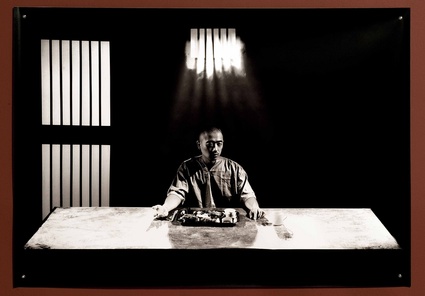 Xijing Men, I love Xijing-the Daily Life of Xijing President, 2009. Photo : Blaise Adilon
Xijing Men, I love Xijing-the Daily Life of Xijing President, 2009. Photo : Blaise Adilon
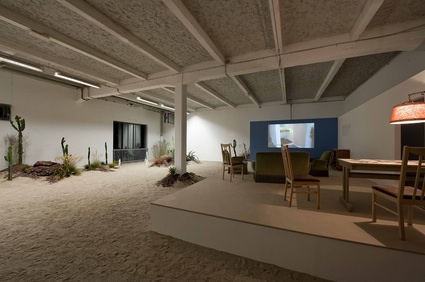 Xijing Men, I love Xijing-the Daily Life of Xijing President, 2009. Photo : Blaise Adilon
Xijing Men, I love Xijing-the Daily Life of Xijing President, 2009. Photo : Blaise Adilon
Beijing literally means “Capital of the North”; Nanjing “Capital of the South”; and Tokyo/Dongjing “Capital of the East”. Where is the Capital of the West then? The Xijing Men (3 citizens from nations that have experienced tense relationships through history: the Korean Gimhongsok, the Chinese Chen Shaoxiong, and the Japanese Tsuyoshi Ozawa) have decided to build it, little by little, for the city of Xijing (西京, “West Capital”) does not yet exist on the maps.
Over the past few years the Xijing Men have embodied a city that moves with the exhibitions they take part in. Each of the performances and actions of the Xijing Men group brings them closer to their ultimate goal: the integration of a fictional place as a city in its own right into the virtual world of Google and interactive maps.
After their organization of rival Olympics for which they turned art galleries on the outskirts of Beijing into fitness centers and after the chance “discovery” of forged historical texts, the Xijing Men went a step further towards the creation of the western nation. This time they have “reconstructed” inside the Sucrière the apartment of the president of Xijing Land. The Xijing flag, heaps of sand, a few cactus, furniture, a stage and videos is all it took to both embrace and disgrace nationalist ideals.
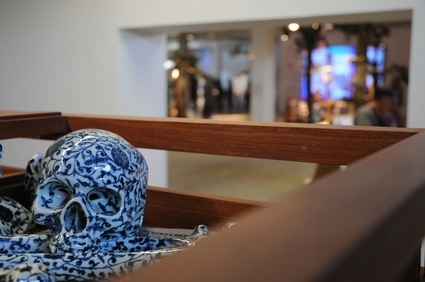 Jiechang Yang, Underground Flowers, 1989-2009. Photo : Zacharie Roy
Jiechang Yang, Underground Flowers, 1989-2009. Photo : Zacharie Roy
Yang Jiechang meticulously disposed 3,000 painted porcelain reproductions of human bones, inside wooden frames as if they were excavated artefacts. “Underground Flowers” is a consideration of the passing of time and the cruelty of political regimes. The artist left China at the age of thirty-three, at the time of the Tienanmen events. The dissolution of the Eastern Bloc, the end of the Cold War and the geopolitical reorganisation of the world date from this same period: they would shape Yang Jiechang’s life and inform his oeuvre. During the Biennale 991 bones were sold to the public – one only per visitor – in return for a minimum donation of 10 euros to Entretemps, an association which provides emergency accommodation in and around Lyon.
